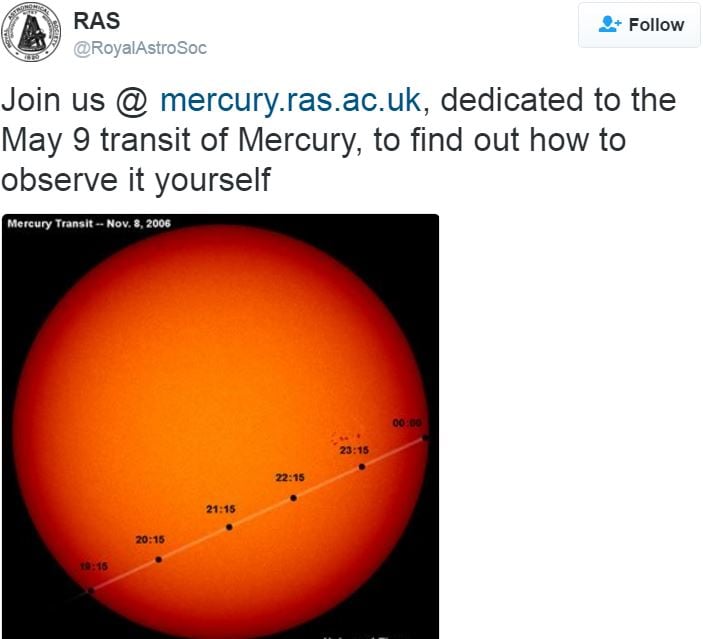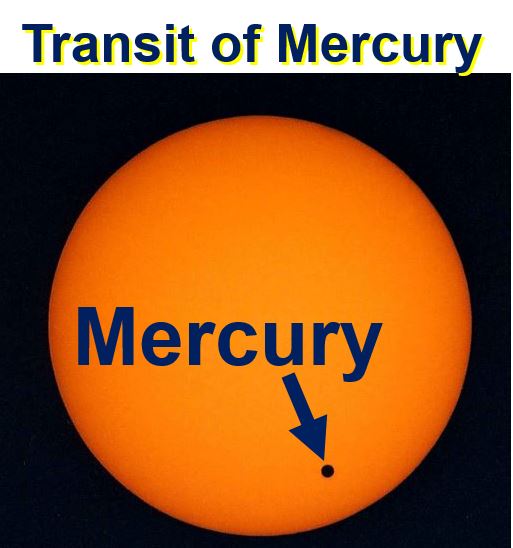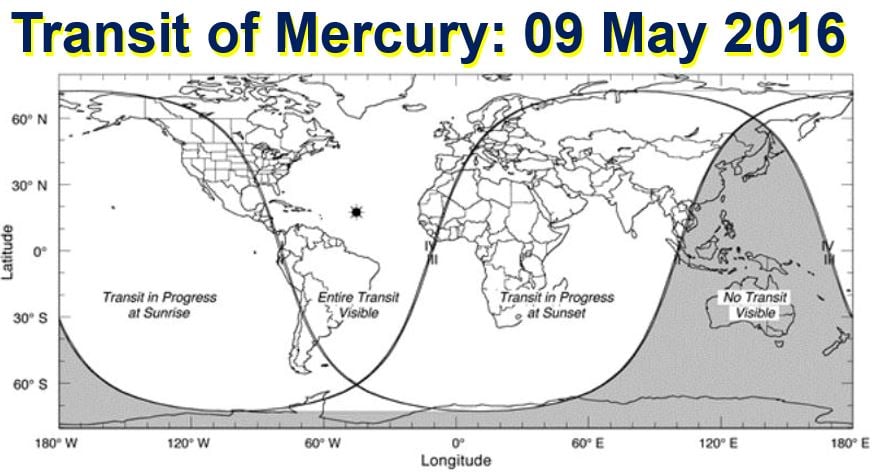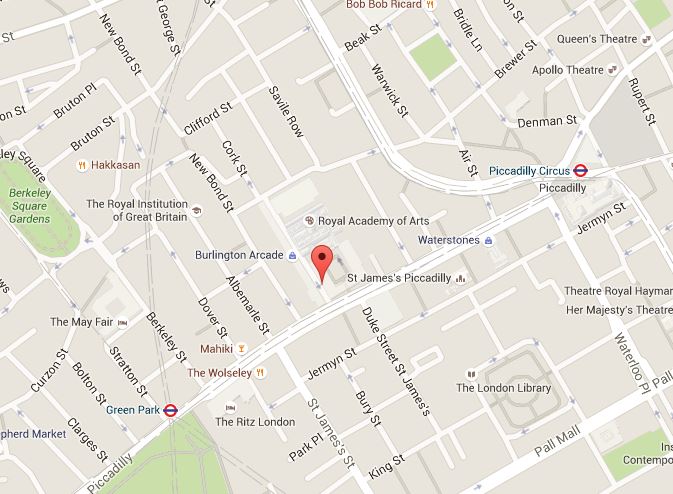You are invited to watch the transit of Mercury with the Royal Astronomical Society, Piccadilly, London, when our solar system’s smallest planet passes directly between the Earth and the Sun. Special equipment will be set up so that members of the public can watch the event in safety.
Transits are relatively rare, says the Royal Astronomical Society (RAS). The last time an event of this kind occurred somewhere on Earth was in 2006, and 2003 in the UK.
After Mercury’s transit on 9th May, the next ones will occur in 2019 and 2032.
 During the transit, the planet Mercury will come between the Sun and the Earth. Mercury will be seen as a small black dot moving across the face of the Sun. (Image: twitter.com/RoyalAstroSoc)
During the transit, the planet Mercury will come between the Sun and the Earth. Mercury will be seen as a small black dot moving across the face of the Sun. (Image: twitter.com/RoyalAstroSoc)
If the skies are clear on 9th May, then British amateur astronomers and keen sky-gazers should have a good view of the transit.
The RAS says the whole event will run from 12:12 BST to 19:42 BST, when the planet Mercury will appear as a slowly-moving silhouetted disk against the bright solar surface.
Specially-designed filters required to see event
The Royal Astronomical Society wrote on its website:
“Because the planet is so small, it only blocks out a tiny part of the light of the Sun. This means it is impossible to see Mercury, and dangerous to try to observe it with the unaided eye, or using a telescope or binoculars without approved specially designed filters.”
The RAS warns:
“Looking directly at the Sun, either during the transit or at any other time, can cause permanent damage to the retina, leading to loss of vision or blindness.”
 Transits of Mercury with respect to Earth are much more common than transits of Venus, partly because Mercury is much closer to the Sun and orbits it more rapidly. The event occurs either in May or November. The last three transits occurred in 2006, 2003, and 1999. The next one will occur on 9th May, 2016. (Image: web.williams.edu)
Transits of Mercury with respect to Earth are much more common than transits of Venus, partly because Mercury is much closer to the Sun and orbits it more rapidly. The event occurs either in May or November. The last three transits occurred in 2006, 2003, and 1999. The next one will occur on 9th May, 2016. (Image: web.williams.edu)
To allow members of the public to experience and observe the transit of Mercury safely, the RAS is running a special event in the courtyard of Burlington House, Piccadilly, London.
There will be experts on hand to operate telescopes fitted with safe solar filters, plus a projection device, to give anybody who comes in the chance to see the transit of Mercury at first hand.
You are invited to come along. The RAS says its staff will be on hand from midday BST until at least 16:00 BST, and most likely until the Sun sets over the buildings next to Burlington House. The equipment and telescopes will be set up outside the Royal Academy.
The RAS will also be hosting a live feed of the transit in its lecture theatre. The RAS library will be holding a special mini-exhibition of Mercury materials. According to the RAS: “Both of these rooms are located in our building on the opposite side of the courtyard to the telescopes.”
 A map of the global visibility of the transit of Mercury of 9th May, 2016. The UK plus most of Western Europe are well placed to observe the event this time. (Image: ras.org.uk. Credit: F. Espenak/eclipsewise.com)
A map of the global visibility of the transit of Mercury of 9th May, 2016. The UK plus most of Western Europe are well placed to observe the event this time. (Image: ras.org.uk. Credit: F. Espenak/eclipsewise.com)
Professor Martin Barstow, President of the Royal Astronomical Society, said regarding the transit of Mercury:
“It is always exciting to see rare astronomical phenomena, such as this transit of Mercury. They show that astronomy is a science that is accessible to everyone, and I would encourage you to take a look if the weather is clear… but do follow the safety advice!”
The entire event will be visible from virtually all over Western Europe, West Africa and the western part of North Africa, most of South America, and the eastern part of North America.
The RAS added:
“Most of the transit (either ending with sunset or starting at sunrise) will be visible from the rest of North and South America, the eastern half of the Pacific, the rest of Africa and most of Asia. Observers in eastern Asia, south-eastern Asia and Australasia will not be able to see the transit.”
There are thirteen to fourteen transits of Mercury every 100 years, making them relatively rare events. However, each one can be observed over a large area of our planet’s surface.
The first transit was observed in 1631, twenty years after the invention of the telescope, by the French philosopher, priest, scientist, astronomer, and mathematician Pierre Gassendi (1592-1655).
 The Royal Astronomical Society, Burlington House, Piccadilly, LONDON, W1J 0BQ. Nearest tube stations: Picaddilly Circus or Green Park. 9 May 2016. Start time 12:00, end time 16:00. (Image: google.co.uk/maps)
The Royal Astronomical Society, Burlington House, Piccadilly, LONDON, W1J 0BQ. Nearest tube stations: Picaddilly Circus or Green Park. 9 May 2016. Start time 12:00, end time 16:00. (Image: google.co.uk/maps)
Grazing transit of Mercury
Some observers may notice that Mercury appears to only graze the Sun during the transit. In such cases, observers in other areas on Earth might be seeing a full transit, while in other regions there may be just a partial transit.
The transit of 15th November, 1999 was a grazing transit for some people and a full or partial one for others. The next such transit will be on 11th May, 2391.
Video – 2006 Transit of Mercury
The first time I watched this time-lapse video of the November 2006 transit of Mercury, I did not see anything apart from the Sun. When I played it again and observed more carefully, I could see a tiny dot moving from left-to-right across the Sun.
